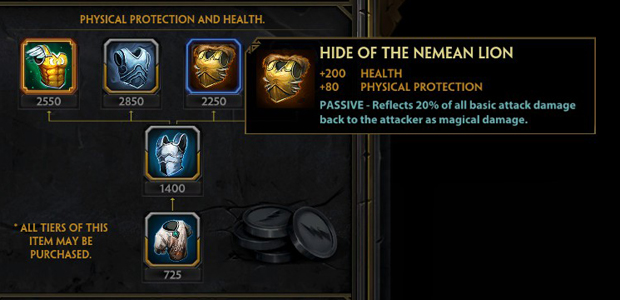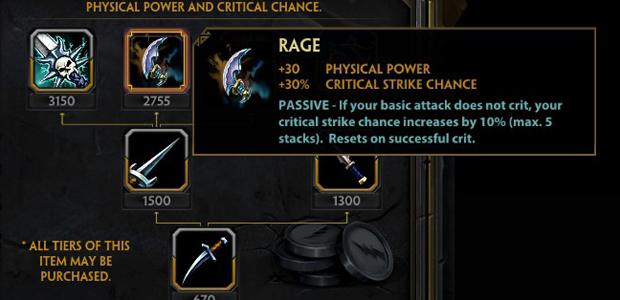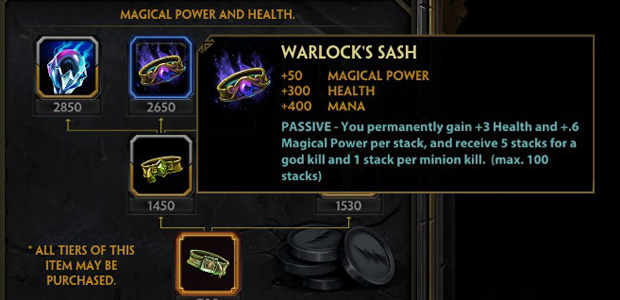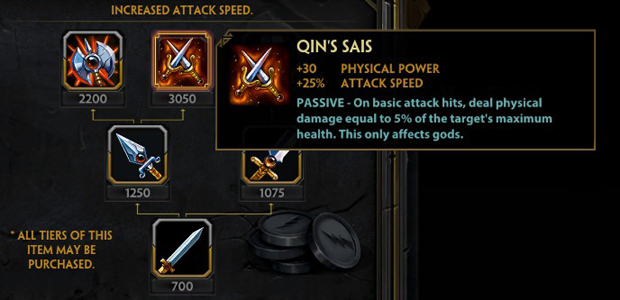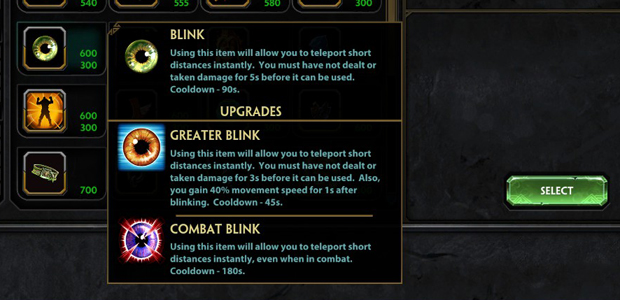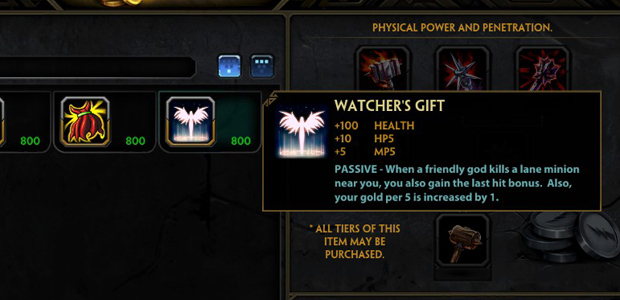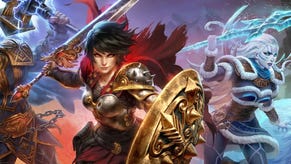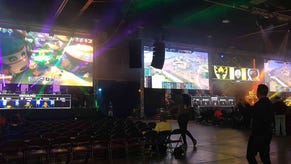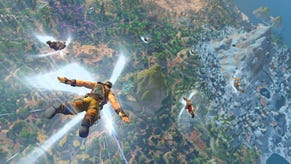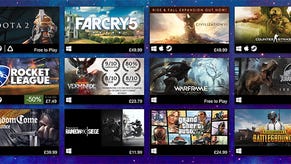Dote Night: Build Me A Smite Build
A Smite-y build
I said a little while back that I wanted to open up Dote Night to include interesting things across the MOBA spectrum so this is the first foray into that. It doesn't mean I've forgotten Dota 2 in any way, shape or form, nor does it mean there won't be Dote Nights about Dota, but I'd like to try out a few things and see how they go. This piece is about how item builds work in Smite. It's an aspect of MOBAs which has never come naturally to me but after speaking with Smite expert and analyst James 'Krett' Horgan it started making a lot more sense – and I don't just mean for Smite. After transcribing this I went to play a few games of Dota and was able to approach my hero builds far more confidently and effectively. So yes, this is about a different MOBA but it exists as part of a broader scene.
If you're looking for a quick and dirty version of what's here you should head to the build guide cheat sheet we've done as a pared down companion, otherwise... read on!
"The core of every build in every game that has a build – even an MMO like World of Warcraft – is the methodology," explains Krett. "What are you doing and how does your build help you do it?"
We're sitting in the media hall at the Smite World Championships and, during a quiet moment, I've asked him to explain how the game's items work. Krett coached one of the Chinese teams who made it to the regional qualifier stages. He also came up with the Unicorn Build – an alternative item build for Hunters who are the attack damage carries (ADCs) of Smite. With that in mind it's no surprise we start off talking hunters.
Hunter builds
"Hunters are probably the most discussed builds in Smite just because they're AD carries. You're looking for maximum damage…. kind of. The question is, 'What do I want to do? Who do I want to kill? How do I want to do it and what utility do I need?' The maximum DPS [damage per second] hunter build you likely won't see in this tournament. It's Warrior Tabi – assuming boots are in every build – Qin's Sais, Executioner, Rage, Deathbringer, Malice. All crit, no lifesteal, no utility, just damage. But when you start to go for realistic builds you have Asi maybe or Devourer's Gauntlets or something with lifesteal to give you sustain and keep you in the game."
The reason for this is that otherwise you'd end up with a hunter who was a glass cannon – capable of dealing great damage but easily shattered – or they'd spend the early game trading hits but running up against an enemy's heal abilities so they wouldn't really be able to capitalise on doing more damage.
"So you start to talk about builds which have utility, or more than just damage. That's when a lot of the more serious methodology discussion comes in on every level. Crit [critical strikes] is the assumed thing for ADC – or damage classes – in pretty much every game. In Smite crit is a compounded stat. What I mean by that is if you just get a crit item it's not that good but if you get a crit item with attack speed items and penetration items and pure power items crit just gets better and better. It's a six item build."
The item combinations he mentions are important, increased attack speed means more hits over a period of time which generally improves your chance of getting a critical strike as well as doing more damage overall. Penetration lets you cut through certain amounts of a foe's protection so you can do more damage.
"If I want to build crit I need raw power. That's where I go for my Devourer's Gauntlets, my Heartseeker, my Transcendence. I'm going to want boots because you need mobility and then penetration's really good. You need a little bit more penetration and you might need some lifesteal if you didn't go for Devourer's Gauntlets. Asi could be good or Executioner. That also give you the attack speed so you're able to fire more than two auto attacks before the fight ends. Then you go into your crit. We use two crit items in Smite – Rage and Deathbringer. Rage is crit smoothing and is usually built first. Crit smoothing means the less you crit the more likely you are to crit in the future. It increases your crit chance every time you don't crit. If you have a Deathbringer and you crit three times you win but you might not crit at all because that's only a 20% chance and that's a gamble.
"We generally end with a Titan's Bane. In every MOBA part of the carry's job is to kill the base. The way penetration works in Smite is there are two kinds. Reduction applies to the target – Executioner does that, it's a debuff. Those don't work on structures. When you get a penetration item which applies to yourself and lets you go through their armor, that's really good against structures as they're highly armoured. Titan's Bane is generally built last because it'll take three to four seconds off a phoenix kill – the penultimate objective."
With Assassins and Warriors Krett explains that Titan's Bane is a more broadly useful item. For Hunters you'd tend to look elsewhere for items dealing damage to players so Titan's Bane is far more about base breaking on a Hunter.
Mage builds
We then turn our attention to mages. You'll usually find one of these manning the mid lane – they're characters like Ra and Agni who I like playing. They get powerful nukes and can do a lot of damage early on.
"Your mage build is going to be your starter items, probably boots next – penetration boots are the standards [Warrior Tabi for physical and Shoes of the Magi for magical]. You also have cooldown boots but generally penetration boots are the standard.
"Then mages go into some sort of raw power item. Occasionally that's a Rod of Tahuti which is the ultimate mage item as it increases the value of all your magical power by 25% but usually it's a stack item [you earn stacks by killing other gods or minions and this increases the effectiveness of the item]. Usually it's Warlock's Sash which gives you health and magical power as you kill more minions or a Book of Thoth which gives you a large amount of power based on how much mana you have and adds some stacks to increase your mana bar. But the stacks aren't particularly important. It's a stack item that gives you over 100 magic power, the stacks only give you 20."
Something which spans classes is the need for penetration items. Krett's advice is that you'll want pen in your build in some shape or form by the 20 minute mark which should be roundabout the fourth item. When you're building for a mage the items to pick from at this point are an Obsidian Shard or a Spear of the Magus.
"This is the easiest example of how penetration matches characters. Obsidian Shard is a nice amount of magic power and 30% penetration on everything. Spear is less magic power, it applies a debuff and [the stacking on the debuff means your second and third damaging abilities will further reduce magical protection]. When you're on a character which has some sort of DoT [damage over time] and the majority of what you do is after the second tick of damage, Spear is amazing. If that's not the case it's pretty bad. The character Hel hits very hard with 3 abilities so spear is only going to apply in full on the third ability and the first is the one that hits the hardest so obs just does more damage."
So for someone like Agni whose passive and first ability have a damage over time element you'd pick up a Spear but for Ra you'd be looking at an Obsidian Shard.
"The standard mage build I give people is penetration boots, Warlock's Sash, Book of Thoth, then Obsidian Shard or Spear, Polynomicon if you're using that auto attack and your combo, Chronos' Pendant for cooldown reduction, Gem of Isolation for the slow – it's really a utility spot. In some cases maybe get a defensive item. Personally if I'm building a defense item on a damage carrier I build a real defensive item because I'm going to commit to that. If I want armor I'll buy an armor item. Last item: Rod of Tahuti should be in every mage build. It increases your raw magic power by 125 and then your total by another 25%."
Assassin and Warrior builds
Assassins and warriors are next on the list. Krett divides them into those who do damage based on auto attacks and those whose damage is ability-based:
"Generally if you're abilities it's base damage so get penetration, get cooldown reduction, and probably get tanky., You don't need that many offensive items. Auto-attack characters have two builds. The highest DPS I mentioned is crit and Qin's Sais. Qin's is kind of an outlier. It's a damage item that's ideal by itself. It does have attack speed and scales the faster you can hit but the real damage scaling is off your opponents' health pool and pen. You can support it with more attack speed or pen but it sort of does the majority of the work itself.
"The other thing to mention is that pen is an amazing stat and pretty much every build should have it. Attack speed is a little overrated because it suffers from diminishing efficiency. The example I use is driving in your car. if you're on a low speed road going 40km per hour then you go 80km you're going twice as fast. If you're on a high speed road going 80km and you go 120 you're increasing your speed the same flat number but only going 1.5 times as fast so the increase is less. If you're at a high attack speed and increase it by a fixed number it's less of an increase than if you're at a low attack speed and increase it by that number."
(Attack speed caps out at 2.5, by the way.)
Attack chains
"There's one exception. We have attack chains in Smite. They're a cool feature that adds flavour because every so often they change up the balance of your attacks. The easiest example of a flavourful attack chain that doesn't do anything is Tyr. Tyr hits 1/0.5/1.5 – when you hit .5 it means you're attacking twice as fast but doing half the amount of damage. Then when you attack 1.5 it's slower but does more damage. Over 3 seconds you're attacking three times and [it averages out as] doing the power of three attacks. If you look at Kali she does 1/.5/.5 which means over 2 seconds she's attacking 3 times but doing 2 attacks-worth of damage. Generally that doesn't change anything but with Qin's Sais, an item that's a proc on every hit, you get 50% more Qin's Sais. Generally characters with fast attack chains are Qin's characters. Hercules for example – he's a really tanky character, good at keeping himself alive – isn't a Qin's Sais character solely because of his attack chain. It's 1/1/1.5 so you're losing damage."
That Unicorn Build
Talking about Qin's Sais leads us back around to an alternative hunter build – one which Krett developed – called the Unicorn build.
"What if we just amplify the power of Qin's and say it scales off attack speed a little bit because of the diminishing efficiency but primarily it scales off penetration. The attack speed is more valuable on a char with lower attack speed. But the scaling on penetration gets better and better. that's why my build focuses on that. It's Devourer's Gauntlets, penetration boots, Qin's Sais, – you need to get them there otherwise you just don't really come online at the right time – Asi, Brawler's Beatstick (which reduces healing but also has 40 damage and 20 pen), Titan's Bane. What this ends up doing is you have Qin's, you have 50 flat penetration which comes after 33% pen and those all apply to towers so it kills towers quickly. Qin's Sais applies only to gods so one of the big weaknesses of the build is it's not good against gold fury and fire giant which are very important. The lifesteal's great, you can tank them all day, but your damage is significantly reduced against those objectives.
"The other thing to mention about the build is that it's weaker on characters with attack speed steroids because – let's say they do roughly the same damage without steroids – when you apply 50% attack speed that's going to be a 25% increase for a crit build. For my build it's going to be less – 20% – because you already have that attack speed. When you look at Anhur who has a penetration steroid that becomes very valuable in my build. When you look at Neith who has no steroids, my build has less of a gap.
"There's a player for Titan – Ataraxia who uses it on every god. I don't advocate that. I say use it on Anhur and Neith because it's less of a loss on them and gives you more utility and versatility. Use it on other characters when you need it, when they have a lot of bruisers, when you want that ability damage. That's how builds should be.
"If you take a look at a class like a warrior that's what people already do. Let's say you go Death's Toll, Warrior Tabi, Jotunn's Wrath – Jotunn's Wrath is an incredible item that's cooldown reduction and damage – after that a lot of warriors just build what they need to. Do I need defence or offence? Do I need to stick to people?"
Recall Timings
It was around this point I asked about recall timings. Recalling is when you go back to your base to heal or buy your items. Unlike Dota 2, there's no courier so you have to purchase the items directly from the fountain (except for Chang'e who has a rabbit courier – a really really slow rabbit courier). The problem with recalling is that if you time it wrong you can miss out on earning gold or you can find yourself late to a teamfight or an objective. So when do you go back and when do you wait?
We'll get back to that point in the moment but it prompted a related discussion about power spikes and when particular gods come online – i.e. when they start being noticeably effective. The Unicorn build is designed to come online an item earlier than the crit build and the time this saves can be vital. The example Krett gives is if you're facing an enemy team with a Freya. Freya is a god who can come online early. She needs maybe 6,000 gold to get to that point and can usually hit that around the 18 or 19 minute mark, perhaps even 15-16 if she's farming well. The unicorn build would allow your hunter to come online about a minute before Freya so you're primed to deal with her.
That coming online is a power spike. There are many others throughout the game. The way the lanes are set up gives you a mage in the middle lane, a warrior on the solo lane, a hunter and support on the dual lane and a jungler/assassin roaming the jungle. The current game has the jungler pressuring mid lane by popping out of the jungle at regular intervals as well as farming the jungle camps. That means they ought to hit level five and thus have access to their ultimate before they have to contest the mid camps. That's another power spike. Same thing goes for a mage reaching level five – they suddenly have this nuke which makes a huge difference to fights. Another is when a support character finishes building a Sovereignty and suddenly offers an awesome protection aura to allies within range. Being aware of these power spikes means being aware of when fights or attempts on objectives are likely to occur.
So let's get back to that recall question. How do you know when to go back to base?
"[Teaching that] is the first thing I do as a coach and it's the hardest thing to learn because it's breaking bad habits. I've done a lot of martial arts and one of my instructors said it takes ten repetitions to learn something and a hundred to unlearn it. Those might not be the exact numbers but the idea is there.
"Mid laners, for example. If you're forced to recall early you can miss a wave [of minions which offer experience] and not hit level five which actually is fairly tight for mid laners now they're sharing with junglers. Or if you have to recall within 30 seconds of a camp spawning you're either not going to be able to get there period or you get there in such a way you can't get a foothold. That will lose you a fight and that fight could lose you the game.
"What it comes down to is the abstract concept of map pressure."
Map Pressure
Map pressure is about knowing what to take and what to leave. It's about being aware of where your opponents are and where you should be. It's about applying force on the right objectives at the right time. Recalling needs to fit around that because you have to be available for those objectives and defences. Krett cites Cognitive Red's performance against DiD as an example of strong map pressure.
"DiD was trying to make a play – for example they had a two man gank on Snoopy who was out of position. They stunned him into a wall and I think they hit an Ares chain. That should kill an Anhur – a hunter alone against two tanky characters. But [DiD's] jungler and mid weren't moving as that gank happened. They weren't covering the rotation from the rest of Cog Red and four players show up, immediately save Snoopy and kill four people. That's map pressure. It's played at a very high level by Cog Red and DiD is still learning that because it's incredibly difficult."
When you leave a lane you have to be aware of what you're risking and what you're giving up versus what you're gaining. That comes with time and with better game sense but for utter beginners Krett offers the following timers as a guide:
"The short answer – just to put it in numbers – at 2.15 minutes. Mid camps are at 3 minutes, buff respawns are at 4.20ish. If you're not there for buff respawns higher level teams will take your stuff. Your next recall is about 5 minutes. The next big camps are at 6ish, buff respawns are at 8 so maybe you could recall at 7. Then next big camp should be 9-ish, maybe 10. It's like that. As a player you can look at the map and see if [an objective timer] is past the halfway mark. If so you need to think about recalling and whether your team can hold that objective or do you need to be there as well."
A rule of thumb I've started to use alongside this is to go back to base 45-60 seconds before I know we'll be trying to take an objective.
But we haven't yet mentioned a crucial role – that of support. Let's wrap up the interview by zero-ing in on the oft-overlooked heroes of the team.
Support builds
"Supports are interesting. There's eventually a point where you're tanky enough that – okay the hypercarries will still kill you – but nobody else will. There's no point at which the hypercarries won't kill you because that would be imbalanced but you hit the point where normal characters don't really hurt you. Smite has a lot of strong tank items. Sovereignty is amazing, Magi's Blessing reduces crowd control duration by 40% and immunes [against an effect] once every 45 secs with a window of cc immunity after that. It also has health and 15 protect all. Stone of Gaia regenerates a percentage of your health every second so that's good as well. Once you get Sovereignty, Magi's Blessing, Stone of Gaia, occasionally Witchblade, occasionally Winged Blade – Witchblade is such a good item other people will probably have it but there are some teams that will buy three or four of an aura item – it's that good.
"Late game supports sometimes struggle on what to get. I'm a big proponent of cooldown reduction which SK Gaming's Badgah likes to do. Fifth item is a Breastplate of Valor – it's a bit more armor which, whatever – you can tower dive longer – but 25% more crowd control? CC is what you do, it's your effectiveness! Movement speed for supports is a function as well. It's getting in position to use your abilities, catching more people and, once your abilities are down, body blocking – restricting enemy movement and what they can hit. But you also see an item like Soul Reaver which every 60 seconds does true damage based on the enemy's max health. That's a huge damage boost on a support.
"When I talk about builds it's Watcher's Gift, Midas Boots, Sovereignty. That's your job. Then generally Magi's Blessing, a Stone of Gaia – maybe just rank 2, that's really good and you can save for rank 3 – but once you get Sovereignty, Magi's Blessing and Stone of Gaia which I believe are non negotiable it's like 'What do I want to do now?' Against some hypercarries you can never fully counter them but you can build items that'll piss them off. Midgardian Mail reduces their attack and movement speed and Hide of the Nemean Lion returns damage based on the true damage they would deal. If you're tanky enough your Nemean Lion can technically out-DPS their damage onto you. That's generally that your opponents are building poorly but it can happen."
And that is something that happens – particularly at the level I'm currently playing. Opponents do build incredibly poorly sometimes so being able to master your items, or at least know the vague direction in which to build, can make the difference between victory and defeat.
N.B. Here's the link for the quick and dirty Smite build guide cheat sheet.

